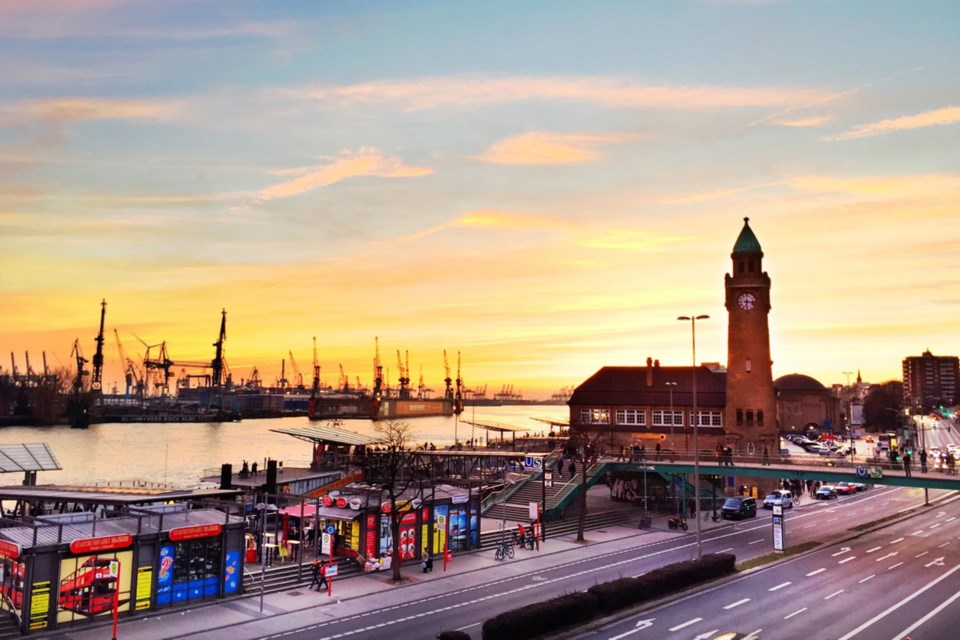GermanyтАЩs second-largest city, Hamburg, is awash with history тАФ and played especially key roles in the stories of 19th-century emigration, the Second World War and the Beatles.
ItтАЩs also a thriving 21st-century metropolis with an inviting harbour boardwalk, avant-garde architecture, and Las Vegas- style nightlife. Every visit here makes me wonder why so many Americans skip it. I love this city.
Even though itтАЩs about 100 kilometres from the North Sea, HamburgтАЩs seaport on the Elbe River was the worldтАЩs third largest a century ago.
But the Second World War devastated the commercial centre, and during the Cold War, trade to the east was cut off. Port traffic dwindled, and so did the cityтАЩs influence.
But Hamburg has been enthusiastically rebuilt, and, since GermanyтАЩs reunification, it has regained its former status as a leading trade centre.
HamburgтАЩs port has evolved with the cityтАЩs needs and changes in shipping technology.
One example is HafenCity, a huge development project that enlarged downtown Hamburg by about 40 per cent.
The centrepiece is the striking Elbphilharmonie тАФ a combination concert hall, public plaza, hotel and apartment complex. Its daring design and huge size fit in well with the massive scale of the surrounding port.
Water seems to be everywhere in this city of nearly 2,500 bridges.
HamburgтАЩs delightful lakes тАФ the Aussenalster and Binnenalster тАФ were created in the Middle Ages, when townsfolk built a mill that dammed the local river.
Back in the 1950s, a law guaranteed public access to the Aussenalster, and today, peaceful paths and bike lanes are a hit with locals.
Along with plenty of downtown parkland, the lakes provide Hamburg тАФ one of GermanyтАЩs greenest cities тАФ with an elegant promenade, the Jungfernstieg, which comes complete with top-of-the-line shops.
Just a block away, HamburgтАЩs massive city hall, built in the 19th┬аcentury, overlooks a lively scene. ItтАЩs flanked by graceful arcades and surrounded by plenty of commerce.
With its bold architecture and salty waterfront atmosphere, Hamburg feels nothing like GermanyтАЩs inland cities to the south. And at first glance, itтАЩs hard to believe that it was one of the most heavily bombed cities in the Second World War.
With its strategic port, munitions factories and transportation links, Hamburg was a prime target for the Allies. On July 27, 1943, they hit the city centre first with bombs to open roofs, break water mains and tear up streets тАФ making it hard for firefighters to respond. Then came a hellish onslaught of incendiary bombs: 700 bombers concentrated their attack on a relatively small area.
The result was a firestorm тАФ a tornado of flames reaching horrific temperatures. In three hours, the inferno killed more than 40,000 people, left hundreds of thousands homeless and reduced 21 square kilometres of Hamburg to rubble and ashes.
Somehow, the towering spire of St. NicholasтАЩs Church survived the bombing. It and the ruins of the church itself are now a memorial, left to commemorate those lost and to remind future generations of the horrors of war. In its museum, youтАЩll see scorched and melted fragments demonstrating the heat of the firestorm.
Though Hamburg is mostly rebuilt, many Second World War-era bunkers were just too expensive to tear down. So they survive, incorporated into todayтАЩs cityscape. In Florapark, a green space in the Schulterblatt neighbourhood, one old bunker is now a graffiti-covered climbing wall.
A bunker in the St. Pauli neighbourhood is filled with concert venues, recording studios and dance clubs тАФ and heavy metal rock bands here never draw complaints from their neighbours.
HamburgтАЩs Reeperbahn thoroughfare has long been the heart of GermanyтАЩs most famous entertainment zone. It gained notoriety as a rough and sleazy sailorsтАЩ quarter filled with nightclubs and brothels.
But, as the city has changed, so has its entertainment district. Today, this street тАФ where the Beatles launched their careers in 1960 тАФ is a destination for theatre and live music. Considered the Broadway of Germany for its many musicals, the boulevard attracts theatre-goers from all over the country.
Outside the city centre, another popular destination is the BallinStadt Emigration Museum. For Germans in North America, Hamburg has a special meaning, because their ancestors may have sailed from this harbour.
Millions of Germans and other Europeans emigrated from this city between 1850 and 1930.
The museum tells the story of emigration through Hamburg from the mid-19th century through the Second World War.
An unforgettable capper to your Hamburg visit is its harbour tour тАФ the best of its kind in Europe. YouтАЩll see plenty of HamburgтАЩs bold new architecture, as well as its more established beach communities. But mostly, an hour-long cruise gets you up close to HamburgтАЩs shipping industry тАФ all those enormous container ships, cranes and dry docks.
Hamburg is one of the great тАЬundiscoveredтАЭ cities in Europe.
A visit here showcases a wealthy city with a strong economy that rose like a phoenix from a terrible recent past.
Rick Steves (ricksteves.com) writes European travel guidebooks and hosts travel shows on public television and public radio. Email him at [email protected] and follow his blog on Facebook.



